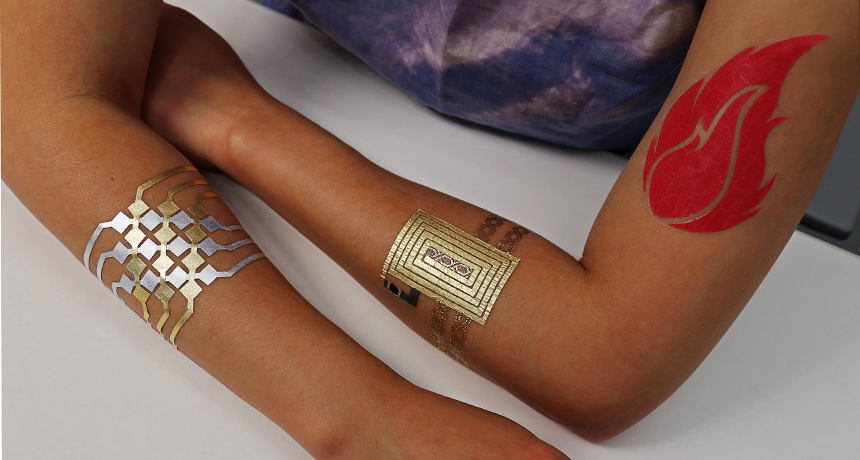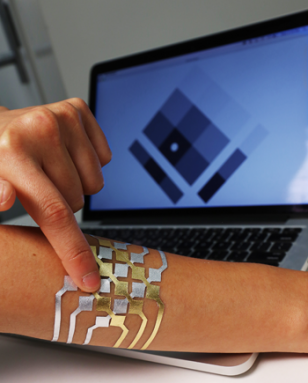Self-designed tattoos are fashionable technology
Researchers create wearable sensors that can control your electronics

These tattoos are not just wearable art. They also let people interact with their electronics.
Jimmy Day/MIT
Ever wish your temporary tattoo could do more than just make an artistic statement? Researchers have created a new type that can sense touch, such as a finger-tap or swipe. The purpose? It allows you to wirelessly control electronic devices.
Wearable electronics aren’t new. Health monitors that attach to the skin can be used to track heart rate, blood-sugar levels and other body features. Those monitors are thin. They’re also stretchy, which keeps them from falling off when our skin flexes. But they aren’t pretty. And they tend to be quite pricey due to the materials used to make them.
Three computer scientists at the Massachusetts Institute of Technology in Cambridge wanted to change that. One of them, Cindy Kao, is also an artist. She pictured tattoos that not only were functional, but also fashionable and affordable.
To create them, she and her MIT colleagues Andres Calvo and Chris Schmandt teamed up with researchers at Microsoft Research in Redmond, Wash. Their first step was to identify a skin-safe material that conducts electricity. Their solution was imitation gold leaf. This thin (about one micrometer thick) sheet of metal isn’t actually gold. It’s mainly copper. It conducts electricity well and most art-supply stores sell it. That was important to Kao, who wanted people to be able to design and craft their own tattoos.
Next, the MIT trio developed the process to create those tattoos. They cut a design from a thin sheet of vinyl. This became their stencil. They then glued several layers of gold leaf onto tattoo paper using the stencil as a guide. (Tattoo paper has a special adhesive that holds the gold leaf to the skin.) The final step was to add a top layer of tattoo paper. The sparkly product was then ready to be applied to the skin using water, just like an ordinary temporary tattoo.
For these fashion accessories to “talk” to electronics, the researchers added either a communications device. A Bluetooth device uses radio waves to share information between two devices located up to 100 meters (about 330 feet) from each other. Bluetooth allows someone’s smartphone to communicate with their car radio or wireless headphones.

Another option: adding a near field communication tag. These tags create a small magnetic field to share information between two devices. But that sharing works only across very short distances — no more than 4 centimeters (1.6 inches). This technology lets some smartphones communicate simply by bringing them close. It also allows people to pay for things at the store by tapping their phone against a payment terminal.
Kao added this remote capability to the tattoos by cutting a tiny hole in the tattoo paper. (This happened before the tattoo was applied to the skin.) For tattoos that use Bluetooth, she slid the ends of two small wires inside. One end of each wire touched the gold leaf. The other connected to a Bluetooth device that wearers could hide under their clothes. Near field communication tags were added in the same way. But these tags are wireless. Kao inserted both ends of the tags into the gold leaf design, creating an electronic circuit.
How this new tech performs
The MIT team recruited people to try out the new tattoos, which they’re calling DuoSkin. To test durability, 10 people each wore a tattoo on their arm throughout a normal 8-hour work or school day. They also wore a strip of copper tape and a piece of electricity-conducting thread. By day’s end, the threads and tape had fallen off many recruits. Only the tattoos were still on the arms of all 10 people.
The team tested Bluetooth technology by having wearers control a music player using their tattoos. The tattoos had built-in buttons, sliders or touchpads. Users could change songs and adjust volume with a tap or swipe. The researchers also tested the ability of tattoos and smartphones to “talk” using near field communication. Phones brought within 1.4 centimeters (0.6 inch) of the tattoo picked up the tag’s frequency. That’s well within the expected range, Kao notes.
The tattoos are “an important step towards wider acceptance of skin electronic technology,” says Yael Hanein. An electrical engineer, she works at Tel Aviv University in Israel. The new designs show wearable tech can be both attractive and inexpensive. And that takes the technology “beyond medical application towards wider consumer use,” she says.
One day, such customizable fashion accessories could control the devices used for everything from medicine to communications and entertainment.
Cindy Kao talks about how to make temporary tattoos, called DuoSkin, with which people can control electronic devices. From MIT Media Lab on Vimeo.
This is one in a series presenting news on technology and innovation, made possible with generous support from the Lemelson Foundation.







